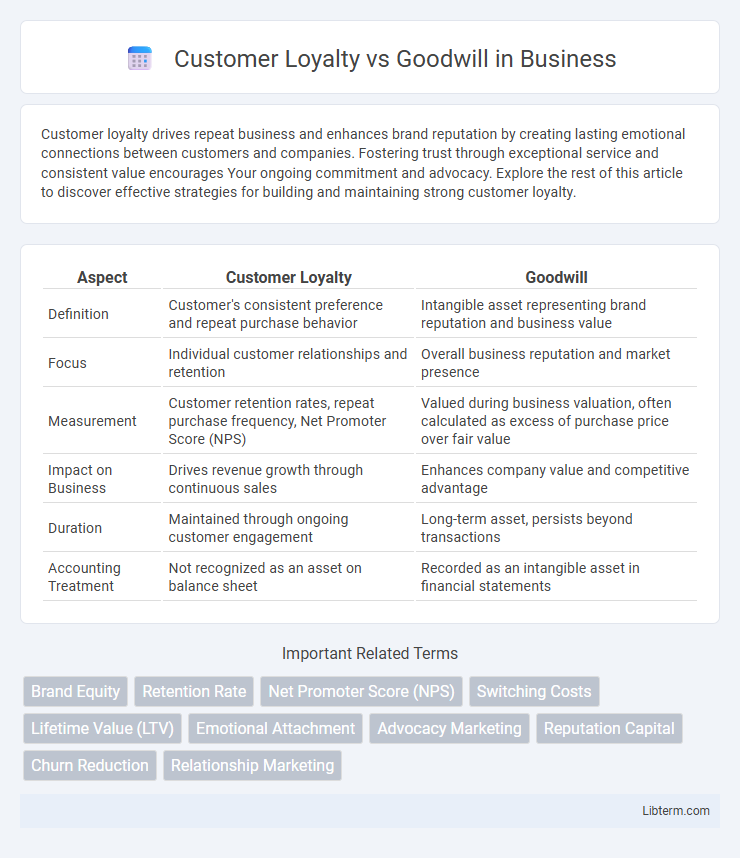Customer loyalty drives repeat business and enhances brand reputation by creating lasting emotional connections between customers and companies. Fostering trust through exceptional service and consistent value encourages Your ongoing commitment and advocacy. Explore the rest of this article to discover effective strategies for building and maintaining strong customer loyalty.
Table of Comparison
| Aspect | Customer Loyalty | Goodwill |
|---|---|---|
| Definition | Customer's consistent preference and repeat purchase behavior | Intangible asset representing brand reputation and business value |
| Focus | Individual customer relationships and retention | Overall business reputation and market presence |
| Measurement | Customer retention rates, repeat purchase frequency, Net Promoter Score (NPS) | Valued during business valuation, often calculated as excess of purchase price over fair value |
| Impact on Business | Drives revenue growth through continuous sales | Enhances company value and competitive advantage |
| Duration | Maintained through ongoing customer engagement | Long-term asset, persists beyond transactions |
| Accounting Treatment | Not recognized as an asset on balance sheet | Recorded as an intangible asset in financial statements |
Understanding Customer Loyalty: Definition and Importance
Customer loyalty refers to the consistent preference and repeat purchase behavior of customers toward a brand or product, driven by positive experiences, trust, and satisfaction. This loyalty is crucial for businesses as it leads to increased customer retention, higher lifetime value, and competitive advantage in the marketplace. Understanding customer loyalty helps companies develop targeted strategies to enhance customer experience, foster strong relationships, and maximize long-term profitability.
Exploring Goodwill: What It Means in Business
Goodwill in business represents the intangible assets that enhance a company's value beyond its physical and financial resources, such as brand reputation, customer relationships, and intellectual property. Unlike customer loyalty, which reflects the repeat purchasing behavior of consumers, goodwill encompasses the overall trust and positive perception held by all stakeholders, contributing to competitive advantage and market positioning. Measuring goodwill often involves assessing the premium paid during acquisitions, reflecting expectations of future profits derived from these intangible elements.
Key Differences Between Customer Loyalty and Goodwill
Customer loyalty refers to a customer's consistent preference and repeat purchases of a specific brand or product, driven by satisfaction and trust, while goodwill represents the intangible value a company holds from its reputation, brand image, and customer relationships. Loyalty is measured through metrics like repeat purchase rate and customer retention, whereas goodwill appears as an asset on the balance sheet during acquisitions or mergers. The key difference lies in customer loyalty being behavior-based and directly linked to sales, whereas goodwill reflects overarching brand equity and market perception.
Factors Influencing Customer Loyalty
Customer loyalty is primarily influenced by factors such as consistent product quality, personalized customer service, and trust built through transparent communication. Customer satisfaction drives repeat purchases, while emotional connections foster long-term retention and advocacy. In contrast, goodwill reflects overall brand reputation and intangible assets, which indirectly support loyalty but are shaped by broader corporate actions and social responsibility efforts.
Drivers of Goodwill in Modern Enterprises
Customer loyalty stems from consistent positive experiences and perceived value, yet goodwill in modern enterprises is driven by intangible assets such as brand reputation, ethical business practices, and corporate social responsibility. Transparent communication, community engagement, and sustainable initiatives significantly enhance goodwill, fostering long-term trust beyond transactional relationships. Investing in employee satisfaction and innovation further fuels goodwill by aligning corporate values with customer and societal expectations.
Measuring Customer Loyalty vs Goodwill
Measuring customer loyalty involves quantifying repeat purchase rates, customer retention metrics, and Net Promoter Scores (NPS) to assess the likelihood of continued business and referrals. Goodwill measurement centers on intangible assets such as brand reputation, customer trust, and perceived value, often evaluated through brand equity studies and customer sentiment analysis. While customer loyalty metrics provide direct insights into behavior, goodwill reflects broader emotional and perceptual factors that influence long-term business sustainability.
Impact on Brand Reputation and Value
Customer loyalty directly enhances brand reputation by fostering consistent repeat business and positive word-of-mouth, leading to an increase in long-term brand value. Goodwill reflects the overall intangible asset derived from customer trust, brand recognition, and corporate social responsibility, influencing investor perceptions and market valuation. Companies with strong customer loyalty experience higher brand equity, while substantial goodwill contributes to resilience during market fluctuations and mergers.
Building Customer Loyalty: Strategies and Best Practices
Building customer loyalty involves consistently delivering exceptional value through personalized experiences, reliable products, and responsive customer service that fosters trust and long-term engagement. Implementing loyalty programs, gathering customer feedback, and leveraging data analytics help tailor offerings to meet evolving customer needs effectively. Emphasizing transparent communication and proactive problem resolution further strengthens emotional connections and encourages repeat business.
Enhancing Goodwill: Practical Approaches for Businesses
Enhancing goodwill involves fostering positive relationships with customers through consistent quality, transparent communication, and corporate social responsibility initiatives that demonstrate a company's commitment to community and ethical practices. Investments in customer service training, responsive feedback systems, and meaningful engagement on social media platforms significantly contribute to building strong goodwill that extends beyond transactional loyalty. These strategies create long-term brand equity and trust, which are essential for sustaining customer loyalty and driving business growth.
The Interplay Between Customer Loyalty and Goodwill
Customer loyalty and goodwill are interconnected concepts where sustained customer loyalty enhances a company's goodwill by fostering positive brand reputation and trust. Goodwill reflects the intangible value created through consistent customer satisfaction, while customer loyalty drives repeat business and referrals that reinforce this value. The interplay between the two creates a virtuous cycle, with strong goodwill encouraging loyalty and loyal customers contributing to long-term goodwill accumulation.
Customer Loyalty Infographic

 libterm.com
libterm.com